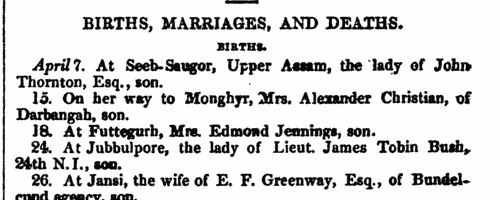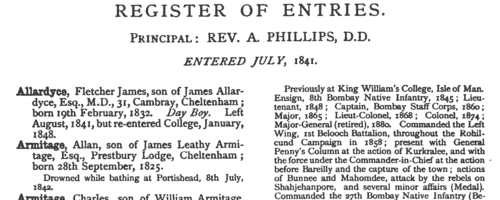Lautour Surname Ancestry ResultsOur indexes 1000-1999 include entries for the spelling 'lautour'. In the period you have requested, we have the following 35 records (displaying 11 to 20): Single Surname Subscription | | | Buying all 35 results of this search individually would cost £166.00. But you can have free access to all 35 records for a year, to view, to save and print, for £100. Save £66.00. More... |
These sample scans are from the original record. You will get scans of the full pages or articles where the surname you searched for has been found. Your web browser may prevent the sample windows from opening; in this case please change your browser settings to allow pop-up windows from this site. Officers of the British Army holding British and Foreign Honours
(1840)
The New Annual Army List, corrected to 7 February 1840, was published in London by Lieut. H. G. Hart. These sections identify those officers who held various British and foreign honours. The lists are annotated with the name of the regiment, &c., and with symbols indicating the officers present in the Peninsula or the South of France (P), and Waterloo (W). The honours covered are Knights Grand Cross of the Bath (GCB); Knights Commanders of the Bath (KCB); Companions of the Bath (CB); Knights Grand Cross of St Michael and St George (GCMG); Knights Commanders of St Michael and St George (KCMG); Companions of St Michael and St George (CMG); Knights Grand Cross of the Royal Hanoverian Guelphic Order (GCH); Knights Commanders of the Royal Hanoverian Guelphic Order (KCH); Knights of the Royal Hanoverian Guelphic Order (KH); and a miscellany of honours from Austria, Bavaria, Belgium, France, Greece, Naples, Netherlands, Persia, Portugal, Prussia, Russia, Sardinia, Saxony, Spain, Sweden, Turkey, Tuscany and Wirtemburg.
LAUTOUR. Cost: £4.00.  | Sample scan, click to enlarge

| British Army officers
(1841)
The Royal Kalendar lists general and field officers of the British Army - five Field Marshals, 95 generals, 138 major-generals, 310 colonels, 637 lieutenant-colonels, 697 majors, in order of precedence according to year of precedence, and with the regiment indicated for each; then there are aides-de-camp to her Majesty queen Victoria; retired officers specially allowed to retain their ranks; and then the queen's land forces, set out regiment by regiment and battalion by battalion, naming the colonel, lieutenant-colonel and major for each, officers of the British garrisons, and of the Tower of London; and the officers of the Royal Regiment of Artillery (including the Field Train) and the Corps of Royal Engineers, by rank.LAUTOUR. Cost: £6.00.  | Sample scan, click to enlarge

| Calcutta Bridegrooms
(1843)
The Indian Mail, 'A Monthly Register for British & Foreign India, China, & Australasia' commenced publication 9 May 1843 as a continuation of the digest of Eastern intelligence that thitherto had formed a part of the Asiatic Journal. The Register section contained notices of births, marriages and deaths from the presidencies of Calcutta (extending across northern India, and into Burma), Madras, and Bombay (including Aden), as well as Australasia, Ceylon, China, Cape of Good Hope, Mauritius, and Singapore.
LAUTOUR. Cost: £6.00.  | Sample scan, click to enlarge

| New Members of the Phonographic Corresponding Society
(1844)
The Phonotypic Journal, published weekly, contains lists of new members of the Phonographic Corresponding Society, alterations (such as changes of address), and lists of contributions to the Fund for purchasing a Phonotypic Fount. The lists of new members give full name (surname first) and address. This index includes the new members, the changes of address, and names (such as 'care of') occurring in the addresses.LAUTOUR. Cost: £6.00.  | Sample scan, click to enlarge

| Deaths, Marriages, News and Promotions
(1845)
Death notices and obituaries, marriage and birth notices, civil and military promotions, clerical preferments and domestic occurrences, as reported in the Gentleman's Magazine. Mostly from England and Wales, but items from Ireland, Scotland and abroad.
LAUTOUR. Cost: £4.00.  | Sample scan, click to enlarge

| The Edinburgh Gazette
(1846)
The Edinburgh Gazette is the official publication in which various Scottish legal notices are issued, as well as promotions and casualty lists for the British army as a whole, and brief lists of English bankrupts. The key source for tracing details of Scottish bankruptcies, insolvencies, and dissolutions of business partnerships.LAUTOUR. Cost: £6.00.  | Sample scan, click to enlarge

| Deaths, Marriages, News and Promotions
(1848)
Death notices and obituaries, marriage and birth notices, civil and military promotions, clerical preferments and domestic occurrences, as reported in the Gentleman's Magazine. Mostly from England and Wales, but items from Ireland, Scotland and abroad. July to December 1848.LAUTOUR. Cost: £4.00.  | Sample scan, click to enlarge

| British Army Officers
(1853)
The 14th volume of the New Annual Army List, for 1853, corrected to 30 December 1852, was published by Major H. G. Hart of the 49th Regiment. It contained 'the dates of commissions, and a statement of the war services and wounds of nearly every officer in the Army, Ordnance and Marines'. The first section, pages 1 to 111, lists officers of the rank of major and above in order of rank and precedence; officers with local rank (112-114); Yeomen of the Guard (115); the Honourable Corps of Gentlemen-at-Arms (116); Headquarters Staff (117); and then (as in the scan) all the regiments and units in order of precedence, giving any regimental honours, with all the officers by rank, and details of postings, facings and agents (118-336). A long section (337-426) then lists officers on the retired full pay and half-pay, including the Royal Regiment of Artillery, Corps of Royal Engineers, Royal Marines and military departments. Then there are lists of officers in the Commissariat Department, the Medical Department, Veterinary Surgeons and the Chaplains Department. A section of Officers on the Foreign Half-Pay gives lists for the German Legion and Miscellaneous Corps (Brunswick Cavalry, Brunswick Infantry, Chasseurs Britanniques, Royal Corsican Rangers, Dillon's Regiment, Greek Light Infantry, Royal Malta Regiment, Meuron's Regiment, Roll's Regiment, Sicilian Regiment, Watteville's Regiment, York Light Infantry Volunteers, the Foreign Veteran Battalion, and the Foreign Corps of Waggoners). After lists of officers in garrisons and military establishments, there are sections listing officers holding Gold Decorations for their parts in various important actions and other British decorations, and those holding medals bestowed by foreign powers. LAUTOUR. Cost: £4.00.  | Sample scan, click to enlarge

| Boys entering Cheltenham College
(1856)
Cheltenham College 'was founded in order to provide for the sons of gentlemen a Classical, Mathematical, and General Education of the highest order, on moderate terms, in strict conformity with the principles and doctrines of the Church of England.'
Andrew Alexander Hunter, the college registrar, compiled the first edition of the College Register in four parts from 1883 to 1886: these merely listed the boys by term of entry, with their dates of birth and names and addresses of their fathers. Circulars were also sent out to all Old Cheltonians whose addresses were known, requesting additional details. On the basis of the returns from these and Hunter's further researches, this much fuller register was published in 1890.
The information after each boy's name is given (where known and applicable) in this format: father's full name and address as of the time the boy entered the college; class and department on entering the college (classes being number from 1 downwards, and these again divided into A and B, some into C and D, others into P (Principal's side) and V. P. (Vice-Principal's side) - 1A was the highest class in each department: besides this, certain others were called Addiscombe, Woolwich, Civil, Direct, Line, Sandhurst, Naval, Special, Preparatory, Latin, and India Civil) and the same on leaving, name of Boarding House (or 'Day Boy'), scholastic and athletic honours attained at the college, and subsequent career (including date and place of death, or present address in 1890, if known).LAUTOUR. Cost: £4.00.  | Sample scan, click to enlarge

|  Persons of standing recommending London police recruits
(1843-1857) Persons of standing recommending London police recruits
(1843-1857)
The Metropolitan Police Register of Joiners (MEPO 4/334) lists policemen joining the force 1 January 1843 to 1 April 1857 (warrant numbers 19893 to 35804). The register is alphabetical, in so far as the recruits are listed chronologically grouped under first letter of surname. It gives Date of Appointment, Name, Number of Warrant, Cause of Removal from Force (resigned, dismissed, promoted or died), and Date of Removal. Although the register was closed for new entrants at the end of 1842, the details of removals were always recorded, some being twenty or more years later. Those recruits not formerly in the police, the army, or some government department, were required to provide (normally) at least two letters of recommendation from persons of standing, and details of these are entered on the facing pages. Where a recruit was only recently arrived in the metropolis, the names and addresses of the recommenders can be invaluable for tracing where he came from. Those recruits not formerly in the police, the army, or some government department, were required to provide (normally) at least two letters of recommendation from persons of standing, and details of these are entered on the facing pages: the names in these are indexed here (the police recruits are indexed separately and not included here). Recruits transferred from other forces or rejoining the force did not normally need recommendations - in the latter case, former warrant numbers are given - but some recommendations are from police inspectors, even other constables. Recruits coming from the army sometimes have general military certificates of good conduct, but most often have a letter from their former commanding officer; recruits recommended by government departments (most often the Home Office) similarly have letters from the head of department. But the great majority of the names and addresses in these pages are of respectable citizens having some sort of personal acquaintance with the recruit. Where more than two recommendations were provided, the clerk would only record one or two, with the words 'and others'. Tradesmen are sometimes identified as such by their occupations; there are some gentry. Although the bulk of these names are from London and the home counties, a scattering are from further afield throughout Britain and Ireland. LAUTOUR. Cost: £8.00.  | Sample scan, click to enlarge

|
Research your ancestry, family history, genealogy and one-name study by direct access to original records and archives indexed by surname.
|













